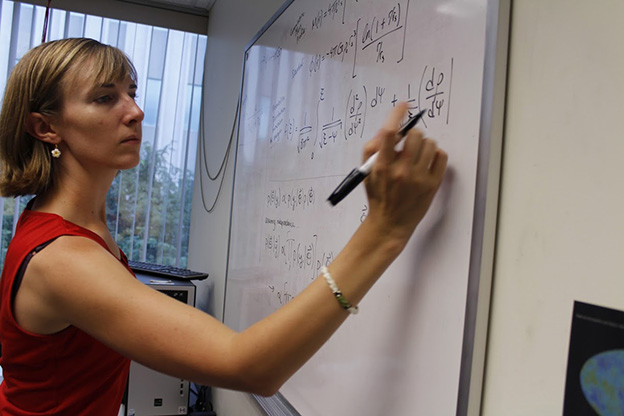Ice dancer turned astrophysicist studies Milky Way’s mysterious dark matter

Gwendolyn Eadie is a graduate student whose eyes are on the skies.
The PhD candidate and astrophysicist spends her days applying statistical methods to data from objects orbiting the Milky Way to estimate the galaxy’s mass, or more specifically, the halo of dark matter that scientists believe surrounds our galaxy.
Eadie says scientists think every galaxy is in a halo of dark matter. But since we can’t directly see or detect dark matter particles – the composition of dark matter is still unknown – it’s hoped that by examining objects orbiting the Milky Way, scientists will be able to better estimate its mass.
“We can compare this mass to the mass from the light we see, and then infer the amount of dark matter in the halo. This information will tell us more about the evolution of our Galaxy and the universe,” she says.
Astronomers often don’t have a lot of formal statistical training, so getting a statistician’s point of view is both helpful and important, according to Eadie.
“Statisticians may know statistical methods that many astronomers aren’t familiar with, and these could be useful in answering questions about the mass of the Milky Way and its dark matter halo.”
Eadie’s area of study falls into an emerging cross-disciplinary field of physics and astronomy, known as astrostatistics – research for which she recently received a Post-Graduate Scholarship from the Natural Sciences and Research Council of Canada (NSERC). Under the supervision of professor emeritus William Harris, Eadie is entering her third year of a PhD with a specialty in astrophysics.
She is one of 26 McMaster graduate students to receive a major NSERC scholarship this year.
(Ice) dancing with the stars
Eadie certainly didn’t predict a future among the stars. Her feet were firmly planted on the ground – or more specifically, on ice.
Following high school, she spent two years training as a competitive ice dancer in Vancouver, Kitchener, and then Barrie, and another year touring North and South America with an ice show.
Then, when she decided it was time to hang up the blades, her sights were set on an English degree. That is, until she sat through a general interest class called Intro to Astronomy at Simon Fraser University.
From the first supernova, she was hooked.
“I always did well in math and science in high school, but I never thought about completing a degree in those areas, let alone graduate work or a career,” she says.
Now when she’s not in the lab, Eadie is busy working with fellow members of the Graduate Women In Physics and Astronomy (GWIPA), a society of mostly Master’s and PhD students at McMaster.
Together with members of Let’s Talk Science and the WISE Initiative, she helps to organize and deliver Girls in Science events – days that focus on encouraging girls to consider a future in science.
This summer brings another success for Eadie with an invitation to present her research at the annual Joint Statistical Meeting in August. The meeting is the largest gathering of statisticians in North America.
Closer to home, she keeps busy as one of the coordinators for McMaster’s 3D Theatre. The latest production, Mars: A World on the Edge, runs in the theatre located in Michael DeGroote Centre for Learning and Discovery.
Beyond the ordinary
For the average backyard astronomer, the twinkling lights in the night sky hold much mystery and wonder. But for a woman like Eadie, who can look up and spot the Andromeda Galaxy or identify various types of stars, has the universe become a little more…ordinary?
“If anything, I’m more intrigued because I know how much is out there and how much we don’t know,” she says.
“Now when I look up, I just go, ‘Wow!’”
